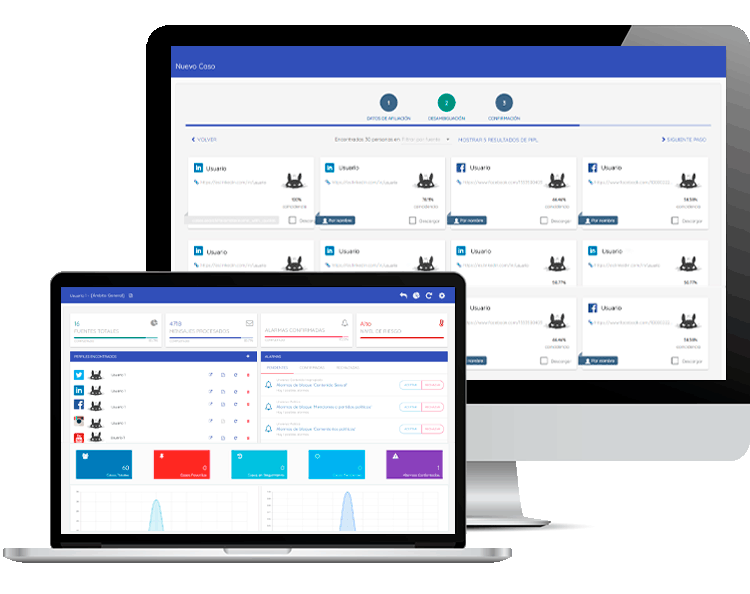What is the value of the fingerprint when it comes to personnel selection or access control processes? This is the key question that we will try to answer in this article. In it, we will take a look at current techniques, the new technologies that are coming onto the market and how to apply them to optimise our team's time and resources.
Recruitment

Historically, the management of recruitment processes has been a manual process. Generally, the process consisted of publishing offers or searching for candidates in databases with profiles. Later on, professional social networks (rrss) such as LinkedIn came into operation, which offered the possibility of reaching more candidates, but also posed a challenge when dealing with such a large amount of information. Finally, one or more cross-checking processes are carried out through tests and/or interviews with HR staff before moving on to technical or more job-related interviews with the team manager.
However, this paradigm is changing. The large volumes of data that recruitment professionals face, not only in terms of candidates, but also in terms of the information they provide, pose a great challenge. Staff have to perform manual filtering, often very generic, and this can lead to a loss of talent that would not have been lost through human review. In addition, the arrival of new generations in the labour market, who are looking for new challenges, and generally change jobs more frequently, makes the process of finding the right person even more important.
The digitalisation of processes makes it possible to apply new techniques that improve the efficiency of these processes. Here we can find automation processes, search in rrsss, Machine Learning models, etc. This allows us to speed up manual search processes and make better use of the time and resources of our teams.
Access control

As is the case during recruitment processes, access control to facilities is of paramount importance. The risks to the organisation when granting access to suppliers, external personnel, etc. to critical facilities are very high. The standard solution is often to fill out consents, backround checks, and/or manual network searches. However, this can be costly and time consuming.
As an example, let's imagine reviewing three different social networks(LinkedIn, Facebook and Twitter), and think that we have to do a manual check of all the messages, posts and comments of the last 5 years of the person. We can have hundreds, or thousands of interactions to review, which is very time consuming and labour intensive. Not only that, but the risk associated with overlooking relevant comments can be very high.
Again, advances in technology make it possible to automate these processes and make them more accessible. By using tools that simplify searches and automate these processes, controlling access to facilities is much safer, faster and more efficient. This, as with recruitment processes, optimises the use of resources and time.
HR challenges

The arrival of new generations in the labour sector and the irruption of digitalisation are changing the paradigm of HR as a talent manager and personnel controller. With this, there are also new challenges to face:
- Changing priorities of the new generations. Issues such as work-life balance, challenges, global objectives of companies are becoming more and more relevant.
- Retention. The average time spent in a company has decreased compared to other generations.
- Teleworking. The rise of teleworking is creating new models for dealing with professionals.
- Complex profiles. The need for new, fast-changing and constantly evolving profiles.
- Brand image. Social networks are the great showcase of our brand to the world, and our employees are ambassadors of this image. That is why their alignment with the company's values must be very strong.
- Cultural change. There has been a major cultural change that has a decisive impact on talent and access management.
The value of the digital footprint

Like the fingerprint, the fingerprint is a unique identifier of each individual. However, it goes beyond a simple physical comparison. Every post, comment, photo, like, and in short every interaction we have on the network is recorded in one way or another somewhere. All of this forms a unique pattern of behaviour for each individual in their interactions with the network.
At this point, however, several questions arise: Can we access this information, what can we do with it?
Every day more and more companies are adding clauses to review the profile of their employees on rrss, at least during the recruitment process. This tool can be very useful to know if we really have the right person for the job or not. It allows us to get to know the candidate better, or the person who needs access to our facilities, and to assess in a safer way whether or not they could pose a risk to the organisation.
Once consent has been received, a review will be carried out to see whether or not the company's values and the individual's values are aligned. This is increasingly important due to the growing power of social media in our lives, and the role our employees play as brand ambassadors. They can both enhance our message and cause serious problems that can lead to boycotts of the organisation.
Benefits of automatic fingerprint extraction
Currently, more than 60% of HR departments say they use social media in their recruitment processes. In addition, 70% say they could generate more value if they could automate HR management processes.
Thanks to digitalisation, more and more companies are becoming aware of the benefits of these practices. Some of which are:
- Time spent. It reduces the hours spent on the process in two key areas:
- When seeking information from open sources
- During the generation of the dossier with the evidence
- Eliminate the need for the use of specific resources dedicated exclusively to the above two tasks.
- Increase the volume of searches
- Increasing the depth of the search
- More accurate risk assessment
"Process automation is the solution to reap the benefits of the new digital paradigms".
Suitability, an automated fingerprint extraction platform

Suitability is Future Space 's OSINT solution for applying advanced analytics to the digital profiles we implement with our clients both nationally and internationally. This tool allows us to search for profiles in a large number of social networks and open sources. It also allows the creation of universes and rules that generate alerts when processing these social network profiles.
It is also possible to set the risk level for different profiles, to process messages and find red flags, and to generate reports with a dossier of the user and the risk to the organisation.
All this from an application designed for business users. Suitability is a fast and automatic tool that does not require programming knowledge to be used. In doing so, it provides everything needed for the automated extraction of digital profiles for both search and selection of personnel, as well as for access control. Keeping organisations more secure and finding the right profiles faster and more efficiently.












